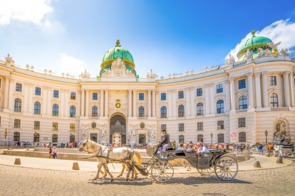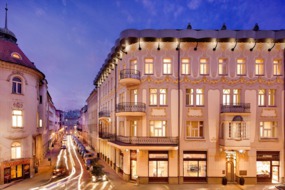
18 April
Setting sail from Nuremberg
Nuremberg, Bavaria's second city, first pops up in the history books in 1050 as a stronghold of the Franks, and later became the unofficial capital of the Holy Roman Empire. Nuremberg was also the centre of the German Renaissance, although in the 20th century it became associated with the Nazis; huge rallies were held here, and Nazi officials were later tried and convicted at the Nuremberg Trials. Happily Nuremberg has bounced back from those dark days, and nowadays the city is a tourist magnet thanks to the beautifully restored old town, Christmas markets and excellent beer.


Don't miss
Schwurgerichtssaal 600 (Court Room 600) of the still-working courthouse is where the Nuremberg Trials took place. It forms part of an extraordinary exhibit detailing the history of the trials.
18-19 April
Germany: Regensburg

Originally founded by the Celts and later an important Roman settlement, Regensburg is one of Bavaria’s lesser known gems. Situated on the northernmost bend of the Danube, it’s a friendly and laid back city, with an exceptionally well preserved medieval centre.
20 April
Germany: Passau

The pretty Bavarian town of Passau, situated close to Germany’s border with Austria, enjoys a unique setting at the confluence of three rivers: the Inn, the Ilz and the Danube. The narrow cobbled streets of the handsome old town, the Altstadt, are quite delightful.
20 April
Austria: Schlögen
21 April
Austria: Melk

The riverside village of Melk is best known for its spectacular abbey, a Baroque masterpiece that dominates the landscape. A Benedictine abbey was first established here in 1089, and the 18th century reconstruction that you can see today is still a working monastery.
21 April
Austria: Dürnstein

One of the prettiest towns in Austria’s Wachau Valley, little Dürnstein charms visitors with its handsome 16th century architecture. Richard the Lionheart was once imprisoned in the castle that sits on the hillside above the town, and the region is also famous for its wine.
22 April
Austria: Vienna

Formerly the centre of the Habsburg Empire, Vienna is as grand a European capital as you can imagine, jam packed full of thrusting, bombastic buildings that stand as a reminder of Austria’s glorious imperial heyday.
23 April
Slovakia: Bratislava

Bratislava, Slovakia’s quaint little capital, straddles the Danube close to the border with Austria and Hungary. The compact old town is the best place to begin your exploration, before heading up to the hilltop castle for commanding views of the city and surrounding countryside.
24-25 April
Arriving in Budapest
Budapest is one of Eastern Europe's most appealing cities, a vibrant and welcoming capital that straddles the Danube. The history of Budapest has been somewhat turbulent - ransacked by the Mongols in 1241, occupied by the Ottoman Turks for over a century, and almost flattened by the Soviets in 1945 - but plenty of older buildings survive, including the imposing Parliament and iconic St Stephen's Basilica. Although a pedant might point out that Budapest has only really existed since 1873; up until then the city's two distinct halves, Buda and Pest, were separate towns.


Our tip
Hungarian cuisine is vastly underrated; don’t visit Budapest without trying goulash, the paprika-infused national dish.
Your home from home



What we love
On board the latest generation of Space-Ships you can expect the spacious accommodation and refined service that Scenic are renowned for, as well as a beautiful sundeck with an inviting pool.
| Capacity | 163 Guests |
|---|---|
| Crew | 59 European Staff |
| Style |
Relaxed and informal during the day, giving way to an elegant evening atmosphere. |
| Inclusions |
|
Tailor-make your trip

Where to stay in Nuremberg
We like the Drei Raben (Three Ravens) in the rebuilt old town.

Explore Nuremberg's rich history
Nuremberg's medieval might and significance as part of the Holy Roman Empire becomes clear in a visit to the Kaiserburg.

Our favourite hotel in Budapest
We like the Hotel Palazzo Zichy on the Pest side of the river, which used to be the residence of Count Nándor Zichy.

A taste of Hungary
If you’re a wine lover, you really should visit the world’s oldest classified wine region, known for its sweet Tokaji aszú dessert wine.











